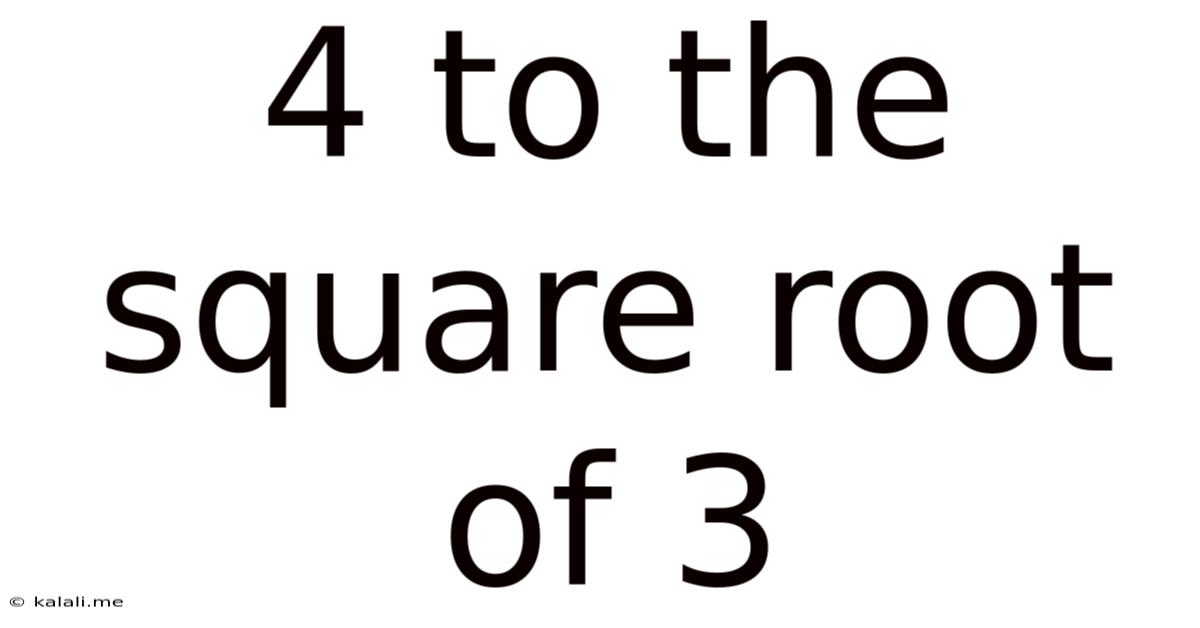4 To The Square Root Of 3
Kalali
Jul 22, 2025 · 4 min read

Table of Contents
Decoding 4 to the Power of the Square Root of 3: A Mathematical Exploration
This article delves into the intriguing mathematical expression, 4<sup>√3</sup>. While seemingly simple, this expression offers a rich opportunity to explore various mathematical concepts, from exponents and radicals to logarithms and approximations. We'll unravel its meaning, explore methods of calculation, and discuss its practical applications and implications within broader mathematical contexts. Understanding 4<sup>√3</sup> requires a solid grasp of fundamental mathematical principles and a willingness to engage with slightly more advanced concepts. This exploration aims to be comprehensive and accessible, guiding you through the intricacies of this seemingly straightforward calculation.
What Does 4<sup>√3</sup> Even Mean?
Before diving into the calculations, let's clarify the meaning of this expression. The expression 4<sup>√3</sup> represents 4 raised to the power of the square root of 3. In simpler terms, it means multiplying 4 by itself √3 times. However, since √3 (approximately 1.732) is an irrational number, it's not as straightforward as raising 4 to an integer power. This is where the power of logarithms and approximations comes into play.
Approximating 4<sup>√3</sup>: A Practical Approach
Calculating the exact value of 4<sup>√3</sup> is challenging without specialized calculators or software. However, we can obtain a close approximation using various methods. One straightforward approach involves using a calculator with exponent functionality. Simply input 4<sup>1.732</sup> (using the approximation of √3) to get a numerical result. Most scientific calculators will provide a precise decimal approximation.
Another method relies on logarithms. Recall the logarithmic property: log(a<sup>b</sup>) = b * log(a). Applying this to our expression:
log(4<sup>√3</sup>) = √3 * log(4)
We can calculate the logarithm of 4 (using base 10 or natural logarithms, ln) and multiply it by √3. Then, we can find the antilog (inverse logarithm) to obtain the approximate value of 4<sup>√3</sup>. This method is particularly useful when dealing with larger or more complex exponential expressions.
Let's illustrate this with base 10 logarithms:
- log(4) ≈ 0.602
- √3 ≈ 1.732
- √3 * log(4) ≈ 1.732 * 0.602 ≈ 1.042
- Antilog(1.042) ≈ 11.0
Therefore, using base-10 logarithms provides an approximation of 11.0. The precision will vary slightly depending on the number of decimal places used in the approximation of √3 and log(4). Using natural logarithms (ln) will yield a similar result but with a different intermediate calculation.
Understanding the Irrational Exponent: The Nature of √3
The square root of 3 (√3) is an irrational number, meaning it cannot be expressed as a simple fraction. Its decimal representation is non-terminating and non-repeating. This characteristic significantly influences the nature of 4<sup>√3</sup>. While we can approximate its value, it's impossible to express it as a finite decimal or a simple fraction.
This irrational exponent introduces a layer of complexity that distinguishes 4<sup>√3</sup> from expressions with integer or rational exponents. Understanding this irrational nature is crucial to grasping the limitations and nuances of its calculation.
Exploring Related Concepts: Exponents, Radicals, and Logarithms
The calculation of 4<sup>√3</sup> necessitates a solid understanding of fundamental mathematical concepts:
-
Exponents: The expression involves raising a base (4) to a power (√3). Understanding exponent rules and properties is essential for manipulating and simplifying similar expressions.
-
Radicals (Roots): The square root of 3 is a radical expression. Familiarity with simplifying radicals and converting between radical and exponential forms is crucial. Remember, √3 can also be expressed as 3<sup>1/2</sup>.
-
Logarithms: Logarithms provide a powerful tool for solving exponential equations and simplifying complex calculations. Understanding the relationship between exponents and logarithms is key to calculating approximations for 4<sup>√3</sup>.
Practical Applications and Further Exploration
While 4<sup>√3</sup> might seem like an abstract mathematical concept, it finds applications in various areas:
-
Calculus: Exponential functions with irrational exponents often appear in calculus problems, particularly when dealing with derivatives and integrals.
-
Engineering and Physics: Exponential growth and decay models, prevalent in physics and engineering, often involve irrational exponents that describe natural processes.
-
Computer Science: Numerical methods and approximations are often used in computer science to handle calculations involving irrational numbers.
Expanding the Understanding: Generalizing the Expression
We can generalize the expression to explore similar problems. Consider the form a<sup>√b</sup>, where a and b are positive real numbers. The methods of approximation and the underlying mathematical principles remain the same. Exploring different values of a and b helps in gaining a deeper understanding of the behavior of such expressions.
Conclusion: A Journey Through Mathematical Concepts
Calculating 4<sup>√3</sup> is more than just a simple arithmetic problem. It's a journey that encompasses crucial mathematical concepts, highlighting the interplay between exponents, radicals, and logarithms. Approximation methods are necessary because of the irrational nature of the exponent. Understanding these concepts and their applications broadens mathematical understanding and allows for tackling more complex calculations and problems in various scientific and engineering fields. This exploration aims to illuminate not only the numerical value of 4<sup>√3</sup> but also the rich tapestry of mathematical principles underlying its calculation and interpretation. This deeper understanding empowers further exploration into more complex mathematical expressions and their applications.
Latest Posts
Latest Posts
-
How Many Cups In One Pound Of Ground Beef
Jul 23, 2025
-
Which Statement Best Reflects The Purpose Of Satire
Jul 23, 2025
-
Students Have Minutes To Complete The Aspire Science Test Apex
Jul 23, 2025
-
How To Pronounce The Aristocats Kittens Names
Jul 23, 2025
-
How Is A Sheep A Letter Homophone
Jul 23, 2025
Related Post
Thank you for visiting our website which covers about 4 To The Square Root Of 3 . We hope the information provided has been useful to you. Feel free to contact us if you have any questions or need further assistance. See you next time and don't miss to bookmark.